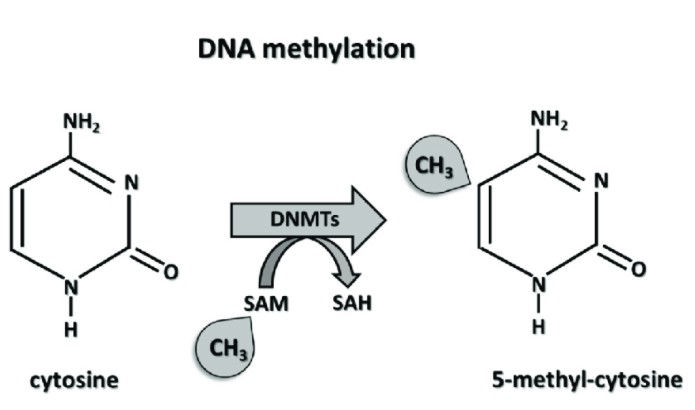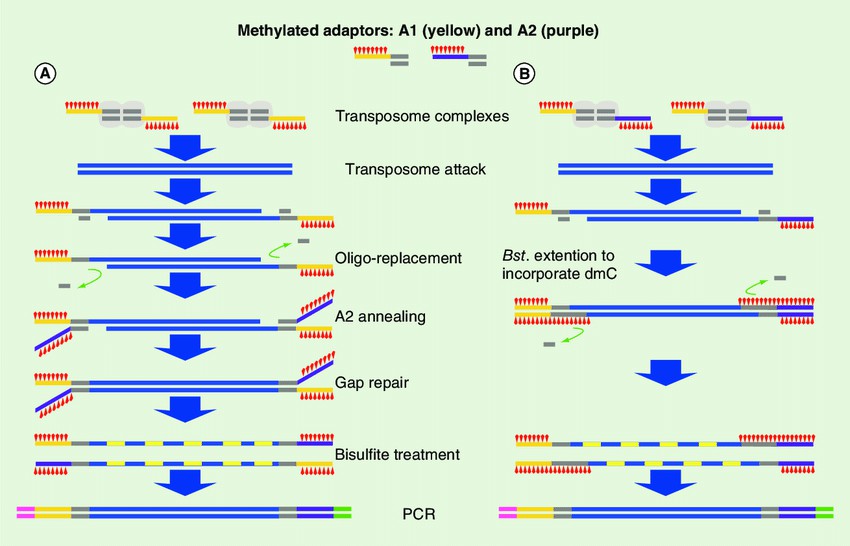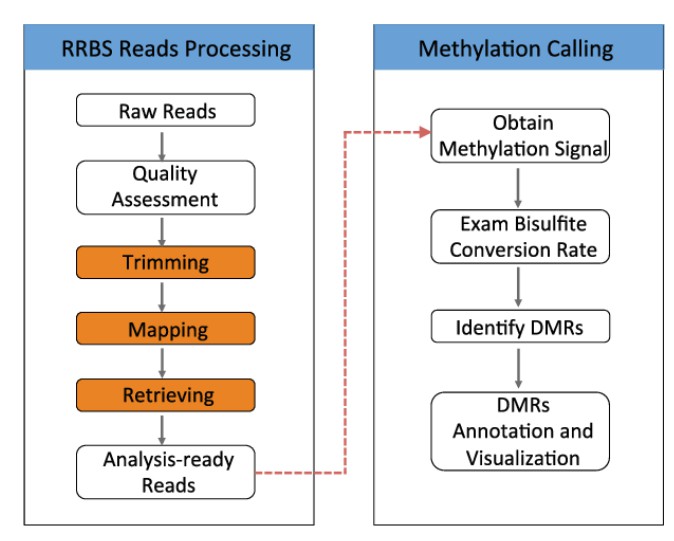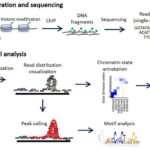Background Introduction of DNA Methylation Research
DNA methylation is a form of DNA chemical modification that can regulate genomic function without altering the primary structure of DNA, causing changes in chromatin structure, DNA stability, and DNA protein interaction patterns, thereby affecting gene expression.
The so-called DNA methylation refers to the covalent bonding of the cytosine 5 ‘carbon position of CpG dinucleotide in the genome to a methyl group under the action of DNA methyltransferase. Numerous studies have shown that DNA methylation is closely related to physiological and pathological processes such as embryonic development [1], genomic structural stability [2], genetic imprinting [3], aging [3], and the occurrence and development of tumors and diseases [4], playing important biological functions in animal and plant life activities. DNA methylation plays a decisive role in the maintenance, self-renewal and differentiation of stem cells, aging and developmental abnormalities of individuals, and the occurrence and development of diseases (such as tumors, diabetes, psychosis, nervous system diseases and other complex diseases). With the continuous innovation of global DNA methylation analysis technology, our understanding of genomic DNA methylation in various aspects such as physiology and pathology has been expanded.

The mechanism of DNA methylation.Marzena (Ciechomska et al,. 2019)
The most extensively studied form of DNA methylation modification currently is 5-mC, which is widely present in the genomes of eukaryotes such as plants and animals, and is known as the “fifth base” of DNA. 5-hmC, on the other hand, is known as the “sixth base” of the mammalian genome and plays an important role in the occurrence and development of diseases such as the nervous system and cancer [6,7]. To learn more about DNA methylation, refer to “What is DNA Methylation”
WGBS
It can accurately detect Gthe methylation levels of all individual cytosine bases (C bases) across the entire genome. Can detect the methylation levels of all loci in the entire genome; It is a relatively early and universal detection technique.
Conventional whole genome methylation sequencing technology uses T4-DNA ligase to break the connector sequence at both ends of genomic DNA fragments by ultrasound. The connector product is transformed from unmethylated cytosine C to uracil U through bisulfite treatment, and then transformed from uracil U to thymine T through connector sequence mediated PCR technology to distinguish whether the cytosine C base has undergone methylation.

The modified tagementation-based whole genome bisulfite sequencing method. (Hanlin Lu et al,.2015)
RRBS
RRBS is the use of restriction endonucleases to cleave the genome, enrich regions with relatively concentrated CpG sites, and perform heavy sulfite sequencing. This technology improves the sequencing depth of high CpG regions, mainly achieving high-precision resolution in CpG islands and regions.
Technical advantages:
1.Single base resolution: Within its coverage range, it can achieve single base resolution;
2.High cost-effectiveness: The sequencing area targets high CpG areas, resulting in higher data utilization.
Technical defects:
1.Low repeatability: The repeatability of the technology is only about 85% -95%;
2.Sequencing depth: A data volume of 10g, with an average sequencing depth of 30X. The proportion of sites with sequencing depth greater than 30X is relatively low.

Schematic view of the RRBS sequencing analysis workflow. (Xuefeng Wang et al,.2015)
MeDIP seq
MeDIP Seq is a genome-wide methylation detection technology based on the principle of antibody enrichment. It uses methylated DNA immunoprecipitation technology to specifically enrich DNA fragments that undergo methylation on the genome through 5 ‘- methylcytosine antibodies. Then, high-throughput sequencing can be used to study high-precision CpG dense high methylation regions at the genome-wide level.
Technical advantages:
Low cost: Significantly reduces the amount of sequencing data (only 1-2G per sample), resulting in low sequencing costs;
Technical defects:
Single base resolution: unable to detect methylation values of individual sites, with a resolution of 50-100bp.
Principles of Whole Genome Methylation Sequencing Technology
Epigenetic modifications do not require changes in DNA sequence to achieve changes in traits, and these changes are closely related to gene function, cellular status, development, aging, diseases, and more. Among numerous epigenetic modifications, one of the most important and widely studied is DNA methylation, and whole genome methylation sequencing (WGBS seq) is undoubtedly the most effective research method.
Whole genome methylation sequencing utilizes the property of bisulfite to convert unmethylated cytosine (C) into thymine (T). After treating the genome with bisulfite, sequencing can calculate the methylation rate based on the ratio of the number of reads on a single C site that were not converted to C but not to T to the number of reads covered. This technology has important application value for comprehensive research on embryonic development, aging mechanisms, epigenetic mechanisms of disease occurrence and development, as well as screening for disease related epigenetic marker sites.
The overall process of whole genome methylation sequencing technology can be divided into five parts, namely sample preparation, genomic DNA extraction, library construction, bisulfite treatment, machine sequencing, and data analysis
Applications of DNA Methylation Sequencing
Epigenetic Regulation in Development
DNA methylation exerts a significant impact on embryonic development by determining cell fate, facilitating tissue differentiation, and supporting the formation of organs—organogenesis. Throughout embryogenesis, genes’ expression is precisely regulated by fluctuations in DNA methylation patterns, thereby fine-tuning the multitude of developmental processes. Technological advancements such as whole-genome bisulfite sequencing (WGBS) provide unprecedented insights into the fluid epigenetic landscape that defines embryonic development. These technologies aid in identifying crucial regulatory zones and the biological pathways that guide cellular lineage selection and morphogenesis.
Aging and Age-Related Diseases
DNA methylation, a pivotal component of epigenetic regulation, undergoes extensive alterations as an organism progresses through its lifespan. These modifications exert a substantial influence on aging processes, playing a significant role in the onset and progression of diseases associated with advancing age. Epigenetic clocks based on DNA methylation, in providing accurate estimations of chronological age, illuminate the expansive biological intricacies inherent to the process of aging. Research endeavors, utilizing methylation sequencing methodologies, have yielded fascinating insights, exposing age-related alterations across genomic landscapes, inclusive of promoters, enhancers, and repetitive elements. The amassed evidence implicates, with notable weight, the role of epigenetic dysregulation in the pathogenesis of a spectrum of age-related conditions, spanning from neurodegenerative disorders and heart-related afflictions to various malignancies.
Conclusion
DNA methylation, as an important epigenetic regulatory mechanism, plays a crucial role in many key biological processes such as development and disease progression. In recent years, the introduction of methylation analysis into early screening of tumor liquid biopsy based on free nucleic acid has pushed the application of DNA methylation to a more hot wave. Compared to traditional chip based detection methods, Whole Genome Bisulfite Sequencing (WGBS) technology based on high-throughput sequencing combines efficient bisulfite conversion with high-throughput sequencing library construction method (Post-BS WGBS), which can accurately analyze methylation sites from a wider range of sample genomes at single base resolution. It can cover all methylation sites and also cooperate with targeted technology to detect low-frequency methylation signals. It has become a mainstream method that has received widespread attention in the industry.
However, as a challenging sequencing method in practical operation, the traditional WGBS library construction method faces many challenges, such as high requirements for initial DNA quantity, cumbersome operation process, long library construction time, and high errors and bias rates introduced by library amplification. With the continuous deepening of its application in the field of cancer, for common samples such as FFPE and ccfDNA with low initial quantity and poor fragment integrity, it will face serious efficiency problems from the early stage of bisulfite transformation, which will seriously affect the quality of subsequent library construction and sequencing.
learn more: Tips for Safely Taking Flexabenz ER 15 mg



